Eco-friendly products
Courtesy : science.howstuffworks.com/
What’s the smartest step you can take to help reduce pollution and live in a more sustainable way? It might simply be to take a look at the environmental impact of the things you buy. Choosing eco-friendly products is not just a fad, nor has the economic downturn slowed the trend. A 2009 study by nonprofit research group Green Seal and EnviroMedia Social Marketing found that about four out of five people said they bought green products despite the recession.
Eco-friendly consumerism may involve making some complicated decisions. For example, a new refrigerator may be more energy efficient than the one you own now, but a good deal of energy goes into manufacturing any appliance to begin with. Is it more eco-friendly to buy the new one or stick with the old if it still works? Likewise, buying locally grown food cuts the energy used for transportation, but growing them in a greenhouse might use just as much energy.
To complicate matters further, shoppers have to take much of the information provided about products with a grain of salt. Manufacturers and retailers sometimes offer unproven, vague, irrelevant or outright false claims. This technique, known as “greenwashing,” is meant to make consumers think products are green when they’re not. For example, claims like “chemical free” and “nontoxic” are often meaningless. Cigarettes might be labeled “natural,” but they’re still bad for you.
The best way to determine whether a product is eco-friendly is to rely on third-party certification. Look for products with labels from reliable organizations that evaluate the environmental impact of each item. For example, Green Seal is a nonprofit organization that conducts a rigorous, scientific analysis of the overall impact of products. Another authoritative certifier is Scientific Certification Systems (SCS), which looks at things like recycled content, organic ingredients and sustainable forestry. Products certified Energy Star by the U.S. Environmental Protection Agency have to meet minimum energy-saving criteria. Ecologo is a certification program run by the Canadian government and recognized worldwide. A good place to sort out all the different labels is Consumer Reports’ GreenerChoices Web site.
1. Can I get along without it? There’s an environmental cost to every product. Reusing current items is often the most eco-friendly strategy.
2. Can I make it myself? Many cleaning products, for example, can be made at home from common ingredients like baking soda and vinegar.
3. Can I buy it used? Buying second-hand clothing, cars or computers avoids the eco-costs of manufacturing new ones. Check yard sales or classified advertisements on Internet sites like Craigslist. The Freecycle Network, a Web site connecting people by region, facilitates passing on used items for free.
On the next page, we’ll find out what actually makes a product eco-friendly.
Figuring Out Eco-friendly Products
Drinking water instead of a sugary soft drink is good for your health, but bottled water is definitely bad for the planet’s health. According to nonprofit research group the Pacific Institute, producing the plastic bottles for Americans’ annual consumption requires the equivalent of more than 17 million barrels of oil and creates more than 2.5 million tons of carbon dioxide. Going with a reusable bottle and filtered tap water instead may be the more eco-friendly route.
Deciding whether a product is eco-friendly isn’t always easy. You need to consider the entire life cycle of the item and look at the impact of each phase. This includes thinking about the following aspects:
- Materials: What is it made of? Does it include recycled material? What about toxic substances?
- Energy content: How much energy went into making it?
- Delivery: How much energy was used to get it to you?
- Efficiency: How much energy does it use when operating?
- Durability: Will it wear out quickly and have to be replaced?
- Disposal: Will it create pollution when discarded? Can the materials be recycled?
- Packaging: Does it include excess packaging that has to be thrown away?
Some products are eco-friendly from one perspective but not from another. For example, they may be made recycled materials but include lots of unnecessary packaging or use a large amount of energy.
Some consumers look at other criteria. You may want to be sure that no animals were used to test the product. Products labeled as “fair trade” refers to those where the producers and workers are not exploited by middlemen. “Vegan” products contain no materials derived from animals. You might look for tuna that has been caught without harming dolphins or “shade grown” coffee that helps maintain forest habitats.
Whatever criteria are important to you, there are some general, simple rules to follow when shopping. Buy large sizes to minimize packaging. For example, a large box of corn flakes is definitely more eco-friendly than the ones that come packaged as individual servings. The packaging should be recyclable, and you should choose reusable products like rechargeable batteries or cloth napkins. Opt for durable, long-lasting products to avoid the waste of “disposable” items. Steer clear of throwaway cameras, pens, razors and similar items.
When you go to the store, always bring a reusable shopping bag (or several) with you. A simple net or cloth bag eliminates the need for paper or plastic bags, saving energy and resources.
On the next page, we’ll learn about where you can look for eco-friendly products.
Sustainable Energy
Sustainable energy may be one of the most eco-friendly purchases you can make. It’s now possible to receive your electricity from companies that generate it from renewable sources like solar or wind. To find out more, contact your local utility or the U.S. Department of Energy’s Green Power Network.
Eco-friendly Product Suppliers
The first place to look for eco-friendly products is at the same stores where you do your ordinary shopping. Many major retail chains have begun to supply products that minimize environmental damage. For example, Home Depot identifies and labels products that are environmentally friendly, everything from all-natural insect repellents to front-load washing machines. The company’s Web site includes a section called “Eco Options” that can direct you to the most eco-friendly alternatives. Lowe’s, which also offers organic and eco-friendly products, offers recycling programs for batteries and home appliances.
Target is another store that has promoted green shopping. The retailer offers a range of eco-friendly products, from reusable bags to natural beauty products. The company has also partnered with NextWorth, a trade-in program, to encourage the recycling of electronic items like cell phones and iPods. Best Buy also offers an electronics recycling program.
When it comes to groceries, many supermarket chains now offer organic produce and other green products. They might also sell foods in bulk to cut down on packaging.
While green products are only a part of the offerings of major retailers, you can probably find local businesses that are committed solely to green shopping. For example, the Sapona Green Building Center in Wilmington, N.C., focuses exclusively on eco-friendly products. Many communities have organized farmers’ markets where you can buy local products in season. Consignment and thrift shops recycle items directly by reselling them.
The Internet is also a great place to search for eco-friendly products. And in many cases, buying online is a better way to shop, anyway. Having items delivered or mailed to your home is often more energy efficient than driving to a store to purchase it. Researchers at Carnegie Mellon University found that online shopping uses 35 percent less energy and carbon emissions compared to making a purchase at a brick-and-mortar store.
There are many Web sites that screen and sell eco-friendly products. BuyGreen.com sets standards for every product based on the item’s entire life cycle and gives it a rating. Ecomall.com and Greenshopper.com are similar central sites where you can shop among many companies that offer eco-friendly products. National Green Pages is a directory of about 3,000 companies that have made commitments to sustainable and socially just operations. Keep in mind, though, that you still might need to do some research to find out just how green individual products are.
A quick Internet search can also provide you with links to manufacturers of all types of eco-friendly products. For example, you can check out the environmentally friendly home products created by Seventh Generation and find out where to buy them from a local source. The Green Products Alliance provides links to member retailers and manufacturers who sell eco-friendly skin care products. Many specialty sellers can be found on the Web with a simple search. They offer items like natural pet products, organic cotton and green office supplies.
Purchasing an eco-friendly product may not seem like a big deal, but if everyone takes a few small steps, it can add up to a giant leap toward keeping the planet healthy.
Learn More:
Up Next10 Tips for Eco-friendly Cooking
Green Your Shopping Quiz
MapQuest TravelDon’t Declutter Your Home Without These Eco-Friendly Tidying TipsEnvironmental ScienceHow Coffee Printers Will WorkHome Improvement5 Eco-friendly Laundry TipsEnvironmental ScienceTop 5 Green Mobile PhonesCraftsUltimate Guide to Organic Clothing
Keep Reading10 Best Green Cars
10 Tips for Eco-friendly Cooking
By: Marie Willsey

You can live green and not feel deprived of the everyday things you love. Learn more! Check out these cool green science pictures.
Going green is rapidly becoming the norm, and the kitchen is a great place to start making environmentally friendly changes to your lifestyle. From the food you buy to the way it’s cooked and stored, you can save energy, reduce your carbon footprint and keep an eye on your budget in many different ways.
Eco-friendly cooking not only benefits the environment; it’s healthier for you and your family, too. Choosing organic vegetables keeps chemicals out of your body, as well the air, soil and rivers.
Many eco-friendly habits are also budget friendly. And these days, who isn’t watching every penny? Finding ways to cook more efficiently — like using the right appliance for the job — can help you reduce monthly energy costs. And you can cut your total supermarket bill by reusing products like aluminum foil and glass containers, buying and cooking food in larger quantities and making the most of leftovers.
Read on to discover our top 10 eco-friendly cooking tips.
Contents
10. Buy from Local Farmers
Tomato lovers know there’s nothing tastier than a fresh, locally grown tomato in the summertime, but it makes sense to buy food from local farmers year-round.
“One of the most eco-friendly things you can do foodwise is to eat local,” says Ann Wilkinson, president of Origin Farms Consulting of Kansas City, Mo. “Not only are you supporting your local farmers, you’re getting the freshest and, in many cases, the best organic and natural foods available. Plus, you’re saving the environment the oil-hungry transportation cost of moving food across the country or the globe to your supermarket.”
Wilkinson encourages shoppers to search out locally grown fruits and vegetables at farmer’s markets, food stands and food co-ops. You’ll enjoy fresher food while supporting small business in your community and helping the environment.
Locating sources of sustainably grown food in your area is as easy as visiting www.LocalHarvest.org. Simply enter your ZIP code to find convenient sources of produce, grass-fed meats and other treats.
Buying food from local farmers can be an adventure for the entire family. Take a trip to a local berry farm and pick your own fruit, pack a picnic and visit a local orchard or visit an artisan cheese maker and see firsthand how Gouda is made.
9. Shop for Organic Products
Do you know what goes into your food? Bite into a pear from a standard supermarket, and you could be consuming more than 20 potentially dangerous chemicals.
Modern agriculture has made great strides in producing enough crops to satisfy demand, but food companies often use pesticides and chemicals that can harm you and the environment. It’s no wonder consumers are seeking healthier options.
Organic farming practices produce crops and raise cattle and poultry without relying on chemicals. Farming the natural way also helps encourage soil and water conservation.
Organic foods provide more nutrients, minerals and vitamins than food grown in large commercial farms. It tastes better, too. Look for organic fruits and vegetables, meats, poultry and dairy from local farmers, markets and co-ops.
Luckily, you can shop green even when you’re in your local supermarket. Products with the U.S. Department of Agriculture (USDA) organic seal provide assurance that the foods are produced without antibiotics, hormones, pesticides, irradiation or bioengineering.
One more thing: Don’t forget to take along reusable tote bags to the grocery store and skip the plastic bags.
8. Find Creative Uses for Leftovers
Everyone knows that leftover Thanksgiving turkey is great for soup, sandwiches and turketti, but smart cooks make the most of leftover meats all year long. Roasting a chicken for Sunday dinner? Save what’s left to make a pasta dish on Monday or toss it into a salad for Tuesday’s lunch. Grill a flank steak tonight and enjoy what’s left for weekend fajitas.
Planning ahead can simplify meal preparation on busy evenings, while helping to save the costs of going out to dinner or ordering takeout. Keep leftover bits of carrots, celery, onions and potatoes to make a tasty soup stock — just add meat or noodles. Pasta dishes like lasagna and chicken casseroles are easy to make in large quantities and freeze in smaller portions to enjoy later.
Many cooks feed their kitchen scraps to a backyard compost pile. Once decomposed, the material makes a great fertilizer for your herb garden. Keep a bin in your kitchen to collect coffee grounds, banana peels, apple cores, eggshells and carrot tops while you’re cooking, then take them outdoors. You could also look into an odor-free, indoor system.
7. Use Aluminum Foil Wisely
Cost-conscious cooks have found creative ways to use and reuse aluminum foil for decades. These habits are also eco-friendly. Wrap lunches, snacks and leftovers in foil to keep them fresh, then rinse and reuse the foil again.
Looking for more smart uses for foil? Line pans and baking dishes with aluminum foil to make cleanup easier, so you use less water. Reuse aluminum foil to clean and scour pots and pans instead of steel wool or plastic pads. You can also use aluminum foil to sharpen scissors and garden shears; simply fold a sheet six to eight times and make several cuts.
Now, you can even purchase recycled aluminum foil from Reynolds Wrap. It’s made from 100 percent recycled aluminum from post-consumer sources such as automobile components, cookware, gutters and siding, as well as scraps from industrial cable. According to the manufacturer, there’s an 80 percent reduction in the amount of energy used during the process of turning recycled material into foil, compared to making it from new materials. Plus, the packaging and core are made from 100 percent recycled paper, and the inks used on the packaging are water-based.
6. Switch to Eco-friendly Cookware
While environmentally friendly cookware won’t make you a gourmet cook overnight, it can help reduce energy usage in your kitchen and prevent harmful chemicals from tainting your family’s food.
Many kitchenware manufacturers, like Cuisinart, are now using a new ceramic technology designed to keep foods from sticking. Traditional nonstick pans are coated with Teflon that starts to break down at temperatures more than 450 degrees Fahrenheit (232 degrees Celsius). Most stoves reach higher temperatures, so the Teflon starts to break down after only a few months.
Pots and pans made with new ceramic-based nonstick technology take less time to heat the surface to the proper cooking temperature because of the excellent heat conductivity of the aluminum it’s made from. Its ceramic coating doesn’t start to break down until temperatures rise above 1,000 degrees Fahrenheit (538 degrees Celsius).
Purchase only the individual pieces you need instead of buying sets with pots that you’ll never use, and select oven-friendly pieces that can be used for multiple purposes. You should also seek designs with tightly fitting lids so that very little heat energy escapes.
Look for cookware made of recycled materials, including handles derived from recycled aluminum. Some manufacturers even offer cookware with handles composed of sustainable materials like bamboo.
5. Cook with Natural Gas
Gourmet chefs have long preferred a natural gas range for sautéing vegetables and simmering sauces because of the ease and precision it provides. Turns out, gas cooktops are also a green choice.
Natural gas stoves are eco-friendly and energy efficient because the fuel is directly used for cooking. For electric cooktops, electricity must be generated from another source of fuel, like coal or gas.
Many professional cooks prefer using gas because of the immediate response and control that the flame offers. There’s no need to wait for the burner to heat up or cool down, and energy usage stops as soon as you turn off the burner. With pilotless ignition systems, gas is being consumed only when it is turned on, lowering energy usage — and costs — by about one-third.
Natural gas cooktops and ranges offer even cooking, high-output burners and low simmer temperatures. And you can still cook if the electricity goes out.
4. Develop Green Habits
Everyday actions add up to big energy savings, so use your appliances wisely. Conserve energy by choosing correctly sized pots and keeping them tightly covered to retain heat. Be sure to keep your stovetop burners clean so they cook more efficiently.
Make the most of your oven by cooking several things at once. Choose cast iron, ceramic or glass cookware to retain more heat and speed cooking time. You can eliminate or minimize preheating to conserve energy. Also, resist the urge to peek into the oven: The temperature drops 25 degrees every time you open the door.
If you’re remodeling, consider that convection ovens cook 25 to 30 percent faster than conventional ovens, saving time and energy.
Another green habit is to always use the right appliance for the job. For example, use a toaster to heat up your frozen waffles instead of heating up a large oven, or choose a microwave to heat up frozen foods or leftovers. Electric teapots offer a quick way to boil water and save energy.
Don’t be afraid to use your dishwasher. It’s a very efficient appliance, and you’ll use less water than by washing dishes. Run it only when it is full, and choose the most efficient settings: light instead of heavy and air-dry instead of heat. Just skip the pre-rinse cycle: It uses up to 20 gallons (75.7 liters) of water per load.
3. Keep Your Cool
Did you know that the refrigerator is one of the major users of household electricity? It’s hard at work every day of the year, and the U.S. Department of Energy estimates that 14 percent of a household’s energy usage goes to this appliance.
The refrigerator does a great job of keeping foods fresh, but make sure you’re using this trusted appliance efficiently. Putting hot leftovers directly into the refrigerator raises the temperature inside, so it has to work harder — and burn more energy — to keep foods cool. Allow your leftovers to sit at room temperature for a while before putting them into the refrigerator.
Check the rubber seal on your refrigerator periodically to make sure it’s doing a good job of keeping cold air in and warm air out: slip a dollar bill into the door. If it slips out easily, call a repair technician to fix or replace the seal.
It’s also best to keep your freezer as full as possible. Fill any empty space with reusable ice packs so it will stay cooler and use less energy.
If you have a refrigerator or freezer that’s more than 10 years old, consider replacing it with an Energy Star qualified model. Newer models are much more energy efficient, and the Department of Energy estimates that if every American home replaced its old refrigerator or freezer with a newer model, we could save enough energy to light more than 9.2 million homes for an entire year and save more than $2 billion in annual energy costs.
2. Eat More Fresh Food
Here’s one more reason to eat healthier: It’s eco-friendly. According to the Environmental Defense Fund, if every American had just one meat-free meal per week, the carbon dioxide reduction would be equal to removing more than 5 million cars from the road.
Choosing an organic apple over a bag of chips is a smart nutritional choice and conserves all that energy used in processing, packaging and delivering the bag, then disposing and recycling the waste left behind. While it might be easier to buy microwave popcorn, bottled lemonade or baby carrots, you’ll save money by making your own. Just buy regular carrots and cut them into bite-sized pieces, for example.
Another way to eat healthier is to grow your own food — especially vegetables and herbs. Whether you plant a garden in the backyard or plant herbs in pots on the deck, there’s nothing like bringing a red pepper or pinch of basil that you’ve grown to your table. If a backyard garden isn’t possible, find a community garden in your area. Many local parks now offer these small garden plots to gardeners who work together to tend their crops.
1. Filter your water
Look to the kitchen sink for eco-friendly ways to conserve water. Filter your tap water to remove lead, chloroform and the taste of chlorine. You’ll save money over buying bottled water, and help reduce the energy used to produce, ship and dispose of plastic water bottles and jugs. Consider a water-filtering pitcher or a faucet mounted filter that screws on to your tap. Either way, you’ll enjoy better-tasting water, save money and help protect the planet.
Another smart move is to attach a low-flow aerator to your kitchen faucet. It mixes air into the water stream and reduces water usage, but doesn’t lower pressure. An aerator with a flow rate of 2.2 gallons (8.3 liters) per minute will save 1.4 to 2.7 gallons (5.2 to 10.2 liters) every day. Aerators are easy to install and can be found at your local hardware store at prices that won’t break your budget.
Lots More Information
Related Articles
- How Solar Cooking Works
- Why do pineapple enzymes tenderize steak — and your tongue?
- How Molecular Gastronomy Works
5 Tips on Eco-friendly Lawn Care
By: Josh Briggs

How much do you know about eco-friendly lawn care?
In 2008, researches made a disturbing discovery in remote areas of Antarctica. Scientists found traces of the pesticide dichlorodiphenyltrichloroethane, better known as DDT, being reintroduced to the arctic ecosystem. For years DDT has laid in wait, frozen in time in the arctic ice. But as climate changes melt the ice, DDT is released and it’s affecting wildlife once again.
DDT has had a tumultuous career. Synthesized in 1874 and identified as an insecticide in the 1930s, DDT became the pesticide of choice for the Allied forces during World War II. It was used successfully to kill mosquitoes in the fight against malaria in Africa. Environmental concerns — namely the effects of DDT on animal reproduction — have since made the chemical one of the most controversial in history.
This story is just part of the growing concern that humans are adversely affecting Earth’s natural environment. We could go on about greenhouse gases, clear cutting and pollution, too. The truth is, humans are an environmental nightmare for our precious planet. Just look at the Great Pacific Garbage Patch. But you can do something for the environment simply by the way you care for your lawn. And we’re going to help you do that.
These five tips on eco-friendly lawn care, listed in no particular order, will help you help the environment. As you’re about to learn, even having a lawn disrupts our ecosystem. Nothing can improve unless someone starts the movement. We’re going to help you get started.
Contents
- 5: Biopesticides
- 4: Mulch and Compost
- 3: Rainwater Irrigation
- 2: Use Eco-friendly Lawn Care Equipment
- 1: No-mow Lawns
5: Biopesticides
As you read in the opening section, DDT works well as an insecticide but isn’t good for the animals that come in contact with it. Research has shown DDT to cause reproductive ailments in birds, such as thinner egg shells. This is an example of a manmade chemical produced to improve the quality of human life. But what happens when it damages the environment?
This is something to consider the next time you spray an insecticide on your lawn: According to the Environmental Protection Agency, there’s some inherent danger to humans and other living creatures from chemical pesticides. But what if you could control pests without harming the environment?
Biopesticides are growing in popularity due to their innate properties. A biopesticide is a chemical made from natural occurring elements that control the insect population rather than kill it. A pheromone pesticide, for instance, disrupts the mating patterns of some insects such as moths and butterflies in the lepidopteran group. These pheromones only affect the targeted insects and have no adverse effects on other animals. Some biopesticides contain scents that lure insects into traps. Others known as microbial pesticides use microorganisms to kill insects. Milky Spore is one such type of microbial pesticide. Once spread, lawn grubs ingest Milky Spore in the soil. Then, within days, bacteria grow and kill the grubs from within. Milky Spore has no effect on beneficial birds and insects.
4: Mulch and Compost
Properly disposing of lawn waste is a cheap and easy way to help the environment. Mulch and compost are yard wastes that have been organically broken down and recycled by Mother Earth. But you need to aid in the process.
You can do one of three things with your lawn clippings after you mow. Your first option (also the easiest) is to mulch while you mow. This is handled easily enough with a mulching blade on your mower. If you don’t have one, you can pick one up at your local hardware or home improvement store for less than $15 and install it quickly, even with limited know-how. Second you can bag clippings for disposal. This takes a little more time and effort, plus you’ll have to pay for yard waste bags and possibly waste removal, too. Thirdly, you can create a compost pile.
Composting recycles organic material to be spread back into the earth for nutritional purposes. Virtually any organic material has some nutritional value that will benefit plants. When grass clippings decompose, they add to the overall nutrition of the compost. You can buy compost bins or build your own relatively cheaply.
With mulching, you get the best of both worlds. Mulching saves you time and energy and the grass clippings provide up to 25 percent of the fertilizer your lawn needs. Lawn clippings can be used for erosion control in flower beds and other areas conducive to runoff from heavy rainfall. All of these benefits are great for the ecosystem.
3: Rainwater Irrigation
Consider water conservation the next time you think about watering your lawn. You don’t have to stop watering completely, but what if you could use rainwater instead?
The best way to water your lawn is to sit under your covered porch having a glass of wine during a rainstorm. Since that doesn’t happen as frequently as lawns typically need, we often resort to man-made irrigation.
But watering lawns has an adverse affect on our environment. According to NASA, lawns account for more irrigation than any single crop in the United States. Lawns cover an estimated three times as much land as corn. Watering all that grass puts a strain on water supplies, not to mention a disruption in the Earth’s water and carbon cycles. But rainwater can offset your irrigation problems.
You can harvest rainwater and store it in drums for future use. It’s actually quite simple. All you need to do is catch it as it flows out of your gutter downspouts. You can buy elaborate systems or make your own rainwater collection system using food-grade plastic barrels. To water a lawn, you’ll need an electric pump to create enough water pressure to power an irrigation system. For optimum results, you can even elevate your rain barrels and let gravity increase the water pressure.
2: Use Eco-friendly Lawn Care Equipment
Parking your car and walking can help prevent polluting the air, and parking your gas-powered lawnmower will help, too. Instead of using gas-guzzling power tools such as lawn mowers, edgers, trimmers and blowers, why not go electric?
You can find both corded and cordless power tools at any home improvement retailer. Battery-operated lawn tools are great for their portability, but not as good for overall performance. Batteries don’t provide as much consistent power as your electrical outlets do. But using an electric lawnmower is where you’ll make the most difference.
According to researchers at the University of Idaho College of Agriculture, gas-powered lawn mowers produce an estimated 10 percent of all air pollutants formed from portable gasoline machines. In addition, mowers don’t adhere to the same EPA standards as gasoline-powered cars, so their emissions could be more toxic. Up until recently, the only way to circumvent the gas mower was the good old push-reel mowers. But now you can buy both corded and battery-powered mowers, too.
If you have a bigger yard, you can even get an electric riding mower. The Hustler Zeon is a zero-turn electric riding mower with a 42-inch (106.7-centimeter) cutting deck. The Zeon mows for 90 minutes on a single (14-hour) charge and has no fluids, filters or fumes to worry about. Not only will you cut down on emissions, you’ll save money in the long run with electric power equipment. Electricity prices don’t fluctuate like gas prices.
1: No-mow Lawns
Mowing the lawn can be miserable. If you’ve ever cut your grass during the summer months in Georgia, you understand. When it’s 100 degrees and the air is heavy with humidity, the last thing anyone wants to do is work outside. So why not just let your lawn grow out?
It’s a fair question. But ask yourself: Do you want to be the one house in the neighborhood that looks like it’s in foreclosure even though it’s very much occupied? Maintaining a lawn and yard does have its benefits. You cut down on the insect diversity by limiting weed growth, for one. An insect population can grow exponentially if you aren’t careful. But who says you need a traditional lawn, anyway?
On the other hand, why not opt for a creeping flower or no-mow lawn instead of grass? Low-level groundcovers such as thyme, sweet alyssum and lavender offer beauty and don’t require the maintenance. A no-mow lawn requires no watering or mowing, and those are two ways to positively impact the environment.
You may want to consider hardscaping. Instead of grass, build a desert or rock scene. Hardscaping requires no maintenance, not to mention you won’t have to worry about erosion. The landscape may be hard, but taking care of it won’t be.
.
Related Articles
- Spend Green to Drive Green
- How to Recycle Tires
- Save Fuel Without Buying a New Car
10 Green Countertops
By: Kim Williamson & Chris Opfer

These days, more homeowners are interested in incorporating green living into their kitchens and they often start with their countertops. See green science pictures.
ISTOCK/THINKSTOCK
With phrases like global warming, greenhouse effect and sustainable management being tossed around in everyday headlines, more people are focusing on the effects of their actions. It’s not just about what manufacturing companies are doing to help or hurt the environment; it’s also about what people do in their everyday activities, whether that’s driving to work, cleaning their bathrooms or shopping for groceries.
So it’s no wonder that eco-friendly home-building and renovation has become an entire industry, causing suppliers and homeowners to do things differently. If you follow any home design shows, magazines or Web sites, you know that the biggest projects, whether they’re new construction or renovations, are often in the kitchen. So, it just makes sense that homeowners would be interested in how to incorporate green living into this popular space.
There isn’t one single green standard, and most of us aren’t environmental experts. A good rule of thumb is to consider three different positions: what’s in the product; what did it take to produce it and get it to me; and what happens to it when I’m done with it? Using these three questions, you can do your research and decide what fits your needs and your desire to be environmentally conscious. To help, we’re going to examine 10 green countertop options.
10: Terrazzo
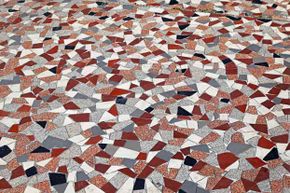
Terrazzo is crushed-up stone and glass, held together with a binding agent. The countertop is then buffed for a nice smooth surface.
ISTOCK/THINKSTOCK
Terrazzo is crushed-up stone and glass, held together by a binding agent. The countertop is then buffed for a nice smooth surface. You can color or stain the terrazzo for a custom finish and it’s a pretty look, so you’ll get lots of style points.
How green is it? If the product is made locally, you cut out transportation costs, which is important since terrazzo is heavy to transport. You can also use terrazzo made from recycled glass, in which case you eliminate the energy needed to obtain new stone or glass.
One disadvantage to watch out for is that the binding agents can sometimes release VOCs, volatile organic chemicals. These chemicals can potentially emit hazardous fumes into the air that can cause visual and respiratory issues. (One such chemical is formaldehyde) [source: Salant]. So, try to use a cement binder made from fly ash, a residue of burning coal. Fly ash would otherwise be landfill material, so using that type of cement binder eliminates the VOC issue and also recycles the fly ash.
Terrazzo is great because it has a long life span, but what happens after that? Unfortunately, it can’t be recycled, so it ends up as waste. Weigh the green positives and negatives of terrazzo, but don’t make any decisions until you read about some other options.
9: Plastic

Plastic can be eco-friendly, if you choose a countertop with a high percentage of recycled material.
ISTOCK/THINKSTOCK
You don’t typically think of plastics when you’re thinking about environmentally friendly products. In fact, traditional plastic countertops are not very green — they’re usually made from a lot of nonrenewable resources. Additionally, making plastic uses a lot of chemicals and the entire process is energy intensive. So, why are we even considering plastic countertops on our list? Because you can alter how green the countertops are by what materials you choose.
Plastic can be recycled, so you can choose a countertop that has a high percentage of recycled plastic. This old plastic would already be on its way to a landfill or dump, so reusing it is a good move. Some countertops are even made with old yogurt containers [source: U.S. Building Council’s Green Home Guide]. Another benefit of recycled plastics is that they don’t release VOCs.
There is a downside, however. This type of countertop, while made from recycled materials, cannot be recycled again, so even though you saved the plastic once, you won’t be so lucky again.
8: Recycled Paper

Kitchen countertops can be made of many types of materials, including recycled paper.
ISTOCK/THINKSTOCK
Before you think a paper countertop pushes the limits of environmental friendliness, let’s discuss what exactly it is. It is actually a paper composite, meaning it is made of paper and other materials, including recycled wood, that are mixed with a binder, usually resin or cement. The end result looks like natural stone.
For green purposes, you want to use as much recycled paper as possible. Additionally, you can use wood products, like pulp, from forests that are sustainable, or renewable resources that can be replenished almost as soon as they are cut. Put these two together — recycled and renewable resources — and you’ve got yourself a very green product.
Before you pat yourself on the back, though, consider the resin used in the countertop. If possible, use a resin that is low- or no-VOC. The resin is just a small percentage of the overall countertop, but anything you can do to help makes a difference.
However, the addition of the resin, a type of plastic, makes the finished countertop nonrecyclable. But it can be reused, or portions can be reused, which extends its life span.
So, if you can make a countertop from recycled paper, what other recycled materials are suitable for countertops?
7: Recycled Aluminum

Aluminum scrap can mixed with a polyester resin to create a nice smooth countertop.
ISTOCK/THINKSTOCK
No, this isn’t a countertop made out of aluminum foil. The recycled pieces are actually aluminum scrap that would otherwise be thrown away. Instead of being discarded, the material is mixed with a polyester resin to create a nice, smooth surface.
Like any product that uses a resin or some sort of binder, you want to check on the amount of VOC emissions; less is more. But it’s the opposite for the aluminum itself; you want a high percentage of recycled aluminum. With some of the brands on the market today, as much as 90 percent of the aluminum is recycled.
Another selling point for recycled aluminum is that it should be able to be recycled again at the end of its life span, provided the manufacturer did not use other substances or finishes that are “less green” in the production. Again, if you do your research, you can know exactly what is in your countertop.
6: Wood

If you’re using wood in your kitchen, look for reclaimed wood or untreated wood from local, sustainable forests.
ISTOCK/THINKSTOCK
It’s easy to assume that natural wood is the best and greenest choice for a countertop. But, as with the other products, you want to investigate.
Ideally, you should use salvaged or reclaimed wood. This cuts down on the need to harvest new product. If you can’t use reclaimed wood, the best choice is untreated wood from sustainable, local forests, which minimizes the costs and energy needed for transportation.
Of course, the wood isn’t the only thing to consider. If you use a sealer or cleaner on the wood, go with a low-VOC emission product. Additionally, wood countertops may have a laminate on top, and often, these laminates contain formaldehyde. Look for a laminate with a minimal amount of formaldehyde, or even better, one that is formaldehyde-free.
Once all of that has passed your inspection, you’ll have a great-looking countertop that has a high green standard. And, the good news is that when you’re ready to remodel again, your wood countertop can be recycled.
5: Bamboo

Bamboo doesn’t require harmful glues and its tensile strength is more than steel’s.
ISTOCK/THINKSTOCK
Bamboo isn’t just that stuff pandas like to chew on; it also makes for an attractive and green alternative to traditional countertop materials like stone and plastic.
A native of Asia, bamboo is a fast-growing — and therefore highly renewable — plant. The material doesn’t require harmful glues and can be fashioned into countertops with standard tools [sources: Whiteley, Stewart].
If that’s not enough to convince you to consider bamboo, chew on this: It has more tensile strength than steel. The material has nevertheless remained reasonably priced compared to less-exotic stone products. It’s also easy on the eyes, ranging in colors from deep chestnut to light blonde and can be cut into squares or rectangles for mixing and matching [sources: Whiteley, Stewart].
Bamboo isn’t without its drawbacks. Some forms are susceptible to stains, not to mention nicks, cuts and slices from utensils and other sharp objects [source: Dwell].
4: Laminate

Laminate can be eco-friendly if you buy one with a high percentage of recycled plastics and paper.
HEMERA/THINKSTOCK
Laminate isn’t necessarily an environmentalist’s first choice. Here’s why: To make a laminate countertop, paper that has been saturated with a resin is compressed at very high temperatures. Next, it is glued to a backing — usually particleboard or plywood — and then glued to a cabinet box. Unfortunately, all of that glue and resin can be bad for the environment, not to mention the number of trees that have to be cut down and processed to get the amount of paper required [source: U.S. Building Council’s Green Home Guide].
So, how can you green it up? First, you can use a high percentage of recycled plastics and recycled paper to make up the surface. Additionally, you can obtain the paper from forests that have sustainable management guidelines. (They don’t wipe out the forests when they harvest the wood.) For the glues, you want to use something that is nontoxic and has low- or no-VOC content. Or, use mechanical fasteners and omit the glue process entirely.
One thing to note: Laminate countertops cannot be recycled, so they will eventually end up in a landfill. However, laminate does offer a big cost advantage over other countertops, though it does get easily marred by heat. If it’s an option you’re considering, it’s good to know how to do it green.
3: Stainless Steel

Some stainless steels on the market contain 100 percent recycled materials.
ISTOCK/THINKSTOCK
Stainless steel is another material you may not have considered as very eco-friendly. After all, it is a mix of several different metals that have to be mined, including nickel, steel and chromium. The mining alone is a disruptive, energy-intensive process that makes stainless steel less than green.
But things are not always as they seem. In fact, there are stainless steels on the market that contain up to 65, 80 or even 100 percent recycled materials [source: U.S. Building Council’s Green Home Guide]. While recycling the material requires energy, it is a fraction of what is needed to extract the metals through virgin mining.
With stainless steel countertops, you don’t have to worry about what environmentalists refer to as offgas or emission of VOCs from the actual countertop. Additionally, you can use mechanical fasteners to attach the countertops so you don’t have resins or glues or other chemicals affecting air quality.
When you’re finished with your stainless steel countertop and ready to remodel again, the countertop can be recycled and reused, another huge plus.
2: Tile

Many designers use glass tile only for accents or backsplashes because it can create a fairly irregular and non-uniform surface which requires a lot of grout.
ISTOCK/THINKSTOCK
There are main two options: ceramic tile and glass tile. Ceramic tile is made of clay, sand and minerals that get fired, glazed, fired again and then finished — a very energy-intensive process, starting with mining of the minerals. So, what can you do to raise the green factor? For starters, you can use recycled materials. Additionally, look for tile that is produced locally to cut down on the transportation costs. Ceramic tile has little or no VOC emissions, so there are no worries regarding air quality. But you should investigate imported tiles because there are different guidelines in different countries, and some imported tiles have lead-based glazes.
Glass tile is often the preferred green countertop because the glass itself can be made from 100 percent recycled materials [source: U.S. Building Council’s Green Home Guide]. The glass recycling process, called sintering, is much less energy-intensive than making glass tiles from new materials.
There are some downsides to tile. Like ceramic, glass tile is heavy to transport, so buy it locally if you can. With both glass and ceramic tile countertops, the tiles are also tough to remove at the end of the counter’s lifecycle. And once you remove them, it’s difficult to use them again.
1: Concrete

Concrete’s reusability factor gives it extra green points.
ISTOCK/THINKSTOCK
Concrete is a mix of water, cement and usually something like sand. The cement is what raises the eyebrows of environmentally conscientious people. Making and distributing cement is very energy intensive: Global cement production accounts for anywhere from 2.5 to 8 percent of man-made carbon dioxide released in the air [source: U.S. Building Council’s Green Home Guide].
The good news for concrete is that cement is only a small percent, around 12 percent, of concrete countertops, and fly ash can actually be used in its place. In the concrete-forming process, fly ash becomes an inert substance, so it won’t emit VOCs or other toxins into the air. Another positive for concrete is that using a sealant to protect the surface will not create any offgas effects; it just increases your counter’s durability.
Speaking of durability, when the concrete countertop’s life span is over, it is very easy to use it again. The material can be crushed, cut up into pieces or reused as whole slabs. This is an excellent benefit because it eliminates the need to produce new concrete.
Lots More Information
Related Articles
- 10 Technologies Used in Green Construction
- Is cork the greenest option for your countertop?
- 10 Green Kitchen Construction Materials
- 10 Green Kitchen Cabinet Designs
Sources
Can you green your mortar and sealants?
By: Kim Williamson
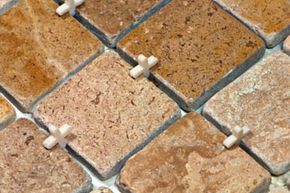
Green Living Image Gallery Several different types of eco-friendly mortar are available on the market, including both water- and solvent-based. See more green living pictures.
©ISTOCKPHOTO.COM/LARRYHERFINDAL
So, you’re doing an eco-friendly renovation in your kitchen. You’ve chosen energy-efficient appliances, green floors and countertops, low-flow faucets, and now you’re giving yourself a pat on the back for being so environmentally responsible. But, have you thought about the products you used on your products? For example, did you know you could purchase a countertop made of recycled materials and then reduce its “greenness” with a sealant or mortar that’s, well, not so eco-friendly?
It seems like a shame to go to the trouble of researching and buying the most environmentally friendly countertops, only to have them installed with a sealant or mortar that is going to negate all of your good intentions. But it is possible to find a mortar or sealant that is green, as well. You just have to do your research and have your contractor and installer do theirs, too.
Many materials used in homebuilding — resins, glues, mortar, caulk and sealers, for example — contain what are called volatile organic chemicals, or VOCs [source: Salant]. These VOCs are used to enhance the products’ performance and durability [source: NAHB Resource Center]. But they also damage air quality, and the U.S. Environmental Protection Agency says that some VOCs are suspected of causing or known to cause cancer in humans [source: EPA].
Some states do require contractors use low-VOC products, but in others they might not use a low- or no-VOC sealant unless you ask them to. One reason is the price; a standard tube of sealant can run you around $2.50, while a no-VOC sealant costs about $8 [source: Miller]. Or, your contractor might not use a low- to no-VOC sealant because contractors tend to stick with products they know and have used before. Ten years ago, it was hard to find low- to no-VOC mortars and sealants. Thanks to the focus on green practices and the enforcement of these practices, these eco-friendly products are increasingly available and of better quality today. But, the building industry still has some catching up to do.
There are a few other things you need to know when you’re selecting a green mortar or sealant. Several different types are available on the market, including both water- and solvent-based. Determine which kind you need for your job, or whether it even makes a difference. Also, know that a low- to no-VOC mortar or sealant takes longer to cure, or set. Keep this in mind when planning, and make sure your contractor knows. The good news is a low-VOC sealant will work just as well as a chemical-based sealant.
Green mortars and sealants are gaining more appeal, with help from states setting more guidelines to protect the air quality. Manufacturers are also educating customers and homebuilders on the benefits of these products. In a few years, they may very well be the standard.
Lots More Information
Related Articles
- 10 Technologies Used in Green Construction
- Which appliances use the most power?
- Kitchen Remodeling Materials
- Fact or Fiction: Sustainable Building
- 5 Myths About Renewable Energy
- Is cork the greenest option for your countertop?
Sources
How Coffee Printers Will Work
By: Jacob Silverman

The RITI coffee printer, which uses coffee grounds as ink, is an exciting new design for a next-generation eco-friendly printer. See more green science pictures.
INHABITAT
Imagine finishing off a nice cup of morning coffee and then, instead of throwing the grounds into the trash, pouring them into a cartridge where they become printer ink. This ingenious idea is the premise of an exciting new design for a next-generation eco-friendly printer — the RITI coffee printer — that we’ll examine in this article.
The coffee printer is reflective of a growing movement for more eco-friendly electronic devices, ones that eschew toxic compounds and use more recyclable components. Some of these gadget designs use bioplastics, biodegradable plastics. At the 2008 Greener Gadgets Conference, computer giant HP presented a printer made out of a corn-based bioplastic. The coffee printer was part of 2009’s conference.
Conventional inkjet printers are very wasteful. On average, if you heed your printer’s warning messages and buy new cartridges when instructed, you’ll be tossing away up to 58 percent of the cartridge’s ink [source: Hayworth]. A printer’s “cleaning” program also causes it to go through costly ink. Adding to the problem, most people don’t recycle their cartridges, and so every year, around 270 million print cartridges, made up of plastic, metal, rubber and other materials, end up in landfills [source: UConn Recycling].
Most printer ink is petroleum-based, which means that like with our transportation sector and plastic production, we use tremendous amounts of oil to make printer ink and toner — around 50,000 tons (45,359 metric tons) of black gold per year [source: Billera]. During manufacturing, petroleum-based inks also produce dangerous chemicals called volatile organic compounds (VOCs). These pollutants can get into the air and groundwater and may lead to a variety of acute or chronic health problems.
Now that we’ve established some of the problems with conventional inks, let’s take a look at some of the benefits of the coffee printer’s design.
Advantages of Coffee Printers
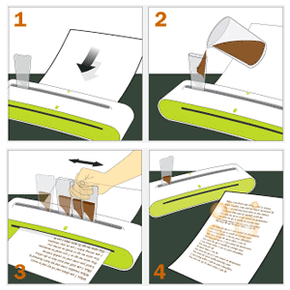
To cut down on the amount of electricity it uses, the coffee printer will require a little elbow grease. The user will have to load the ink case with ink (coffee grounds) and move it back and forth to accomplish the printing.
INHABITAT
The coffee printer is envisioned as being as environmentally friendly as possible. Consequently, the current design appears to use little electricity, though presumably it would have to use some, at the very least for the LED indicator lights on the outside of the device and to push the paper through the printer. Printers also require heat to bond the image to the paper. But the coffee printer could use a standard USB connection to siphon off energy from the computer and, of course, to transmit printing instructions from the computer to the printer. However, most inkjet printers (and this design appears to resemble one) require a standard power cable.
Perhaps the most exciting aspect of this printer design is that it uses a basic household product that traditionally goes to waste. Load in some coffee grounds and water, and you have homemade ink. And besides coffee grounds, the printer can use tea dregs. The grounds or dregs and water are loaded into a reusable “ink case” rather than a wasteful ink cartridge.
So, how do you turn coffee or tea dregs and water into print on a page? This alluring idea is still in the concept stage, so there aren’t any patents for us to peruse. But, the general idea can be seen in the instructions from the original sketches, which basically call for moving the ink case back and forth, thereby dripping coffee- or tea-colored water onto the paper and forming text or images.
Some users may appreciate this little bit of manual labor, as it means they will be more involved in the printing process, turning it into something like a craft. After you’re done, you can still find a sustainable manner in which to dispose of your coffee grounds — many people compost them — but before that, you can, quite literally, squeeze out every last drop of useful material.
Some ink cartridges are quite expensive (particularly for high-volume color or photo printing), so the coffee printer, by using materials that you’d normally throw away, may be a cheaper alternative. Plus there are no trips to the office-supply store, no trying to find the correct kind of cartridge, and no worrying about recycling old cartridges. Instead of misleading warning messages on your computer — which may pop up long before your ink is actually going to run out — you can clearly see when your ink supply is low.
Printing on My Morning Joe?
Among some coffee drinkers, the idea of latte art is taking off; specially modified printers are used to “print” images or designs on the top, foamy layer of coffee drinks.
Disadvantages of Coffee Printers

After you’ve finished printing, you can still find a sustainable manner in which to dispose of your coffee grounds by composting them.
INHABITAT
In considering the coffee printer, it’s important to note that this is a speculative design, but that does not mean that there isn’t room for criticism, even in the concept stage. Chief among the design’s defects is that the ink color and quality are limited by the materials on hand, and who knows if the ink will stay on the page for as long as other inks? The coffee scent may remain, though some users will appreciate that familiar, earthy aroma.
Cost may in fact be an issue, as one batch of coffee grounds may not produce much ink. That is, if you can even get the ink loaded: Loading the ink is a precarious process, involving manual labor, time and possible spills.
Is this sort of a machine even viable? The current design depicts the printing process as something like “drawing” with a coffee-filled cartridge. Obviously, that is not a way to produce crisp text and clear images, nor would it be pleasant to move the cartridge manually to draw on 10 or 20 pages. But even if a more conventional printer design were adapted to accept this kind of ink, your ink supply is still tied to your coffee or tea consumption. You also won’t be able to print in other colors, including black, without incorporating dyes.
There are already many other alternative, environmentally friendly types of ink out there, including vegetable-oil inks and metal-free inks. Inks derived from vegetable oil are often considered eco-friendly and sustainable because they don’t produce VOCs and come from several different types of crops.
Soy ink is a widely used alternative to traditional inks, many of which are derived from petroleum. Developed by the Newspaper Association of American in response to the oil crisis of the late 1970s, soy ink hit the market in 1987 and now occupies 22.5 percent of the U.S. printing market [source: TreeHugger]. It’s considered cost competitive and is used by up to 90 percent of American newspapers, particularly for color printing [source: Schmidt].
There are also various soy-based options for home and office printers. In fact, soy ink has become so successful that the National Soy Ink Information Center, which disseminated information about the benefits of this greener ink, closed shop [source: NASIC]. However, be careful: Some inks that claim to be soy ink actually only have a small percentage of the stuff in them; the rest is usually petroleum-based ink.
For more information about printers, alternative inks and similar topics, visit the links on the next page.
Lots More Information
Related HowStuffWorks Articles
Sources
5 Eco-friendly Laundry Tips
By: Sara Elliott

Forget the dryer, hang your clothes outside to save energy and money.
ISTOCKPHOTO/THINKSTOCK
Laundry duty is actually a great example of an activity that has the potential to be both resource intensive and a significant polluter. Doing the laundry can use a substantial amount of water and energy and release a pile of pollutants into the environment, too. You can make wash day more Earth friendly, though. With some tweaking, a blast from the past and maybe a shiny new appliance, you can make your laundry practices a whole lot greener — and save money over the long haul, too.
Let’s take a look at five green laundry tips that will make your kids call you the green goddess, or god, as the case may be.
Contents
5: Line Dry
In the olden days, before homes had two-car garages and central air conditioning, outdoor clotheslines were as common as rain barrels and victory vegetable gardens. In a society that recycles ideas more than objects, clotheslines, rain barrels and vegetable gardens are all coming back in style. In the case of clotheslines, this means you can once again dry your laundry in the fresh air without the neighbors thinking you’ve fallen on hard times.
Nowadays, clotheslines come in streamlined styles that can make it easy to line dry your blankets, towels and dainties indoors or out. This includes retractable lines that can be extended when you need them and hidden out of sight when you don’t.
Giving up your dryer, part of the time at least, has some advantages beyond reducing your carbon footprint. Your clothes will last longer because they’ll lose fewer fibers from being knocked around during the tumble drying process. They’ll smell fresher, too. If you’re doing the line drying honors indoors (which is easier than it sounds), you’ll also be producing a humidifying station that will keep your home more comfortable during the winter months.
Soften Your Clothes in the Dryer
If you love the idea of line drying your clothes but hate the stiff, scratchy results, try putting those line dried garments and other household textiles in the dryer for 10 minutes after you bring them back indoors. They’ll soften up and smell great. It’s the best of both worlds.
4: Buy New

No matter what you buy, be sure to compare energy use!
COMSTOCK/THINKSTOCK
A standard top-load washing machine with a center post agitator uses 40 to 45 gallons of water per wash load. Since the average family washes 400 loads of laundry a year, that’s a lot of water (16,000 to 18,000 gallons). Switching to a high-efficiency washer will cut that water consumption by half or more, depending on the variety you choose. That’s not all. Most of the energy expended washing clothes is used to heat the water. When your washer uses less water, you use less energy, too.
High-efficiency washing machines come in front as well as top-load varieties. If you go with a front loader, you’ll probably get the most water savings. If you opt for a top-load, high-efficiency model, you’ll still get water savings, and you’ll gain up to 20 pounds of extra washing area over an old style top loader. Energy-efficient, top-load washing machines don’t have center post agitators. They use a roiling tossing action to get clothes clean.
3: Think Green
Small changes can add up over time. When you wash clothes, be energy smart with these tips:
- Wash full loads. It saves water, energy and time.
- Pay attention to the amount of detergent you use. Too much detergent reduces a washer’s efficiency and dumps more pollutants into local ecosystems. Always read and follow the directions on your detergent box.
- Wash clothes assembly line style. When you use the residual heat in your dryer from the previous load to help start a new load, you save energy. So get in the habit of washing multiple loads sequentially. Pull one load out of the dryer (to fold elsewhere), and then put a new, wet load in right away.
- Use timed drying. Timed dryer settings are convenient and eco-friendly, so be sure to match the drying time to the load every time you dry clothes. For instance, nylon underwear dries faster than, say, a load of denim jeans.
- Wear your clothes more than once. You may change your clothes every day, but that doesn’t mean you have to wash all of your garments after a single wearing. It’s a good bet that many of the outer garments you throw in the laundry through habit aren’t dirty at all. They may just need a few minutes in the dryer to get creases or wrinkles out.
2: Wash Cold
The evidence is pretty irrefutable: Most of the energy you use in the laundry goes toward heating the wash water. Switching to cold water washing is the single greatest way to save energy in the laundry room. It can be a big adjustment, it’s true, but there are ways to make the switch and still get clean clothes: Consumer Reports gave one cold-water washing formulation, Tide Coldwater, high marks based on recent tests. There are also lots more cold water cleaning options on the market today than there were even a couple of years ago. Washing machine manufacturers are also tweaking their products to make them work better with cold water detergents.
You don’t always need a special detergent to clean clothes in cold water, either. Your regular hot water detergent will work fine for some cold water washing chores, especially if the items involved aren’t white and don’t sport greasy stains. Experiment with cold water washing, at least once or twice. The energy you save will be your own.
1: Green Products
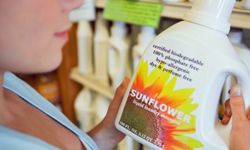
Think green when it comes to your laundry detergent!
CREATAS/THINKSTOCK
Laundry aids like detergent, fabric softeners, bleach and stain remover contain an alphabet soup of chemical ingredients that wash down the drain and into the water supply. A couple of decades ago it was easy to think that all that chemical stuff, like scouring powder, detergent and toilet bowl cleaner, just disappeared down the drain forever. Now we know drinking water can contain trace amounts of hundreds, if not thousands, of artificially introduced chemicals — everything from cancer drugs to paint solvents. We may need legislative help to regulate some of the effluent in our water, but it’s in our power to control the chemicals we decide to use and pour down our home drains.
Choose laundry products that are promoted as biodegradable, green or environmentally friendly. Don’t stop there, though. Look for products that are made with plant-based ingredients, and avoid products that contain chlorine bleach or artificial fragrances. Whenever possible, look for product endorsements from environmental organizations you trust.
You might also consider using a few simple homemade options in the laundry: White vinegar makes an effective water softener. Lemon juice is a mild fabric bleach, and you can make a simple and effective laundry detergent using baking soda, borax and a few other common ingredients.
Lots More Information
Related Articles
- 10 Green Laundry Cleaning Tips
- Green Fashion Isn’t Skin Deep
- 10 Green Laundry Cleaning Tips
- 8 Green Cleaning Tips for Special Fabrics
- 10 Ways to Greenify Your Home
- How Laundry Detergent Works
- Laundry Guide
- How Washing Machines Work
Sources
Top 5 Green Mobile Phones
By: Julia Layton

After heavy criticism, the mobile-phone industry has started going green.
©ISTOCKPHOTO.COM/PIKSEL
If you care about the environment at all, disposing of electronics is seldom a simple task. You can’t just throw them in the trash bin, and recycling them often costs a chunk of cash — if you can even find a place to do it. If you’re lucky, there’s an electronics store near you with promotional free-recycling days, or, if the piece of electronics in question is a cell phone, you can find a nearby donation drop-off for a charity.
Why the hassle? Electronics components, and cell phones especially, are made of dangerous substances. A mobile phone is made of hundreds of different substances, some of which are toxic, including PVC, phthalates, zinc, lead, brominated flame retardants and arsenic [source: Reedy]. When a cell phone ends up in a landfill, it sits there, and sits there, sometimes for hundreds of years, giving those toxic substances lots of time to leach into the ground and water supply.
Thus the focus on recycling or donating your mobile phone — beyond conserving manufacturing resources, it’s crucial keep it out of a landfill. But more than 80 percent of the 150 million phones discarded each year still end up in the trash [source: Wenzel].
In response to heavy criticism, the mobile-phone industry has begun to focus heavily on greening up its product. In 2006, Nokia introduced a whole line of phones and accessories free of PVC, and in 2008, the company marketed the first phone with no toxic flame retardants [source: Reedy]. LG removed harmful beryllium from its phones and is researching both environmentally friendlier paints and biodegradable plastics for its products [source: Reedy]. It’s not an easy process, since eco-friendly plastics are still a new industry and are not always as sturdy as the traditional stuff [source: Reedy].
All of the top handset makers are getting in on the “green phone” trend to varying degrees. In this article, we’ll look at five of the best examples of eco-friendlier phones and find out what makes them greener than their traditional counterparts.
At No. 5, we’ve got a phone from Sony with a reduced carbon footprint.
Contents
- Sony Ericsson C901 GreenHeart
- LG Solar-powered Phone
- Motorola W233 Renew
- ZTE Coral 200 Solar
- Samsung Blue Earth
5. Sony Ericsson C901 GreenHeart
Sony Ericsson is making some pretty far-reaching changes in its handsets. The company has stated that it plans to reduce the carbon footprint of its entire body of products by 15 percent by 2015, and the C901 GreenHeart is a step in that direction [source: LCE].
Manufacturing and using the phone, according to Sony, results in 15 percent fewer CO2 emissions compared to other Sony models [source: LCE]. It achieves this reduction through a variety of eco-friendly features, including a casing made of 50 percent recycled plastic, electronic instead of paper user manuals, and a lower-energy display. Sony also painted the phone using water-based (instead of solvent-based) paint and created a 100-percent-recycled-plastic headset to go along with it.
Some other, non-environmental features:
- Size: 4.1 x 1.8 x 0.5 inches (105 x 45 x 13 millimeters)
- Weight: 3.8 ounces (107 grams)
- Display size: 2.2 inches (5.6 centimeters)
- Camera: 5 megapixels, 16x zoom
- Built-in functions: GPS, media player, Bluetooth, Internet
- Onboard memory: 120 MB
The C901 GreenHeart is scheduled for release by the end of 2009.
Up next: an alternative-energy phone.
4. LG Solar-powered Phone
Currently a late-stage prototype without a fancy name, LG’s solar-powered phone is one of a very few handsets to harness alternative energy as part of its design.
LG, like Sony, is on the green bandwagon but in a good way. The company has promised to remove a bunch of toxic substances (like brominated compounds and PVC) from its handsets by 2010, and another bunch by 2012. Along those eco-lines, this new solar-powered phone doesn’t have to be plugged in to charge.
It has a solar panel built into the back of the handset, as part of the battery cover. If it’s sunny enough, you could go without a plug — at least briefly. Ten minutes of sun exposure will get you three minutes of talk time. With continuous exposure, the phone can stay in standby mode on solar power alone — but the solar power is mostly a “top off” feature in this phone.
Details on features are a bit scarce now, but as for availability, the company says the phone will be on sale in Europe by the end of 2009 [source: LG]. It will ship in packaging made of recycled paper and soy inks.
Up next, the Motorola Renew.
3. Motorola W233 Renew

Motorola’s Renew is “carbon neutral.”
PHOTO COURTESY OF MOTOROLA
Motorola has come up with a phone it’s touting as “carbon neutral.” The neutrality doesn’t come so much from the way the Motorola W233 is built, although the phone does boast some nice green features.
For one thing, the phone’s casing is made entirely from recycled plastic water bottles. And according to the company, producing the Renew requires 20 percent less energy than producing some other Motorola models [source: Ganapati]. The Renew conserves paper, too with its smaller packaging, which is made from 100 percent post-consumer recycled paper.
The “carbon neutral” feature is more about Motorola than it is about the phone. Motorola buys carbon offsets to cover the emissions produced in the production, distribution and use of the Renew throughout its lifetime. And the phone ships with a pre-paid envelope for recycling the handset when that lifetime is over.
Some additional specs:
- Size: 4.3 x 1.8 x .6 inches (109.2 x 45.7 x 15.2 millimeter)
- Weight: 2.9 ounces (82.2 grams)
- Display size: 1.6 inches (4 centimeters)
- Camera: None
- Built-in functions: MP3 Player, Internet
- Onboard memory: <64 MB
Up next, a solar phone that’s fully solar.
2. ZTE Coral 200 Solar
All of the phones we’ve looked at so far are green by choice, following a trend toward building devices that are less damaging to the Earth and human health. The ZTE Coral 200 Solar is green by necessity. It’s designed for “off the grid” areas where plugging in to recharge a phone is not really an option.
The Coral 200 is totally solar. A built-in solar panel recharges the phone’s battery. It doesn’t have many bells and whistles — it’s a pretty basic phone for basic service needs — but for 2 billion people with limited access to conventional electricity, it’s an ideal mobile phone.
Jamaica’s DigiOrder Web site reports the phone comes with 16 ringtones and weighs 2.3 ounces (64 grams) [source: DigiOrder]. Beyond that, specs and features are mostly unknown at this point. The Coral 200 should be available in limited markets in the second half of 2009.
Up next: a green phone with all the features.
1. Samsung Blue Earth
Here are two phrases you probably never thought you’d hear together: “solar power” and “touch screen.”
Samsung has developed an eco-friendly phone that could be as popular as it is eco-friendly. It comes with an integrated solar panel that Samsung says reduces up to 34.6 percent of battery power; with one hour of sun exposure, the phone can give you 10 minutes of talk time, and 12 hours of sun will get you 4 hours of talk [sources: Miller, Engadget, SBE]. The casing is made from both renewable materials and recycled plastic; and the phone is free of toxic brominated compounds and phthalates.
Blue Earth is loaded with other green functions, like a one-touch energy-saving display mode, an energy-efficient charger and applications like “Eco Walk,” which tracks how many steps you take and tells you how much CO2 you’re saving by walking instead of driving. And on top of the “I’m so green” functions, it has a full-color touch screen.
Full specs and features aren’t out yet, but it was unveiled to the 2009 Mobile World Congress to much excitement. The phone is slated to be available in Europe by the end of 2009 [source: LaGesse].
For more information on green mobile phones and related topics, look over the links on the next page.
Lots More Information
Related HowStuffWorks Articles
- How Gasification Works
- How Waterless Toilets Work
- How Ocean Power Works
- How Solar Thermal Power Works
Sources
Ultimate Guide to Organic Clothing
By: Maria Trimarchi

Violence-free silk scarves are displayed on a shelf at OrganicAvenue, a vegan general store in New York.See green living images.
SPENCER PLATT/GETTY IMAGES
In our imaginations, organic clothing usually isn’t very fashionable. It reminds us of Birkenstocks, shapeless tunics and burlaplike textures — tie-dye optional. But our imaginations are stuck in the 1970s. Organic and alternative fibers have come a long way since then.
Organic clothing is made of all-natural, non-synthetic materials and is a part of the organic agriculture movement. This movement emphasizes farming and processing that work with nature and help minimize air, soil and water pollution. Organic clothing materials come from plants that have not been radiated, genetically modified or treated with synthetic or chemical pesticides. Any product labeled organic, whether it’s a T-shirt or an apple, has to meet national standards set up by the United States Department of Agriculture (USDA).
Green Living Image Gallery
Related to organic clothing is sustainable clothing. Sustainable clothing emphasizes the reuse and recycling of materials and is part of the environmental awareness movement. Both organic and sustainable clothing are green and environmentally friendly.
In this article, we’ll explore the different fabrics used in organic and sustainable clothing, find out where to buy these fashions and learn about the environmental impact of non-organic fibers.
Contents
Organic Fabrics

DESHAKALYAN CHOWDHURY/AFP/GETTY IMAGES
Organic fabrics like cotton, wool, silk and hemp must meet regulations set by the Organic Trade Association regarding fiber processing, production, dyeing and non-toxic handling. It’s important to look for organic certification on labels to ensure that a product is actually organic. Sustainable fabrics are produced without federal guidelines and certification.
Organic cotton is the most popular type of organic fabric. According to the Organic Consumers Association, the demand for organic cotton clothing doubled between 2005 and 2006 [source: OCA]. Organic cotton is also used in personal care items like sanitary products, cotton swabs and baby diapers, as well as home goods like sheets, towels and even stationery.
Organic wool, silk and hemp are also popular organic materials. Hemp is a highly durable natural fiber that requires no pesticides and little water to grow. Because it’s a renewable resource, farmers are able to grow hemp crops year after year. Hemp fibers can be used in clothing, skincare products and paper. To make hemp fabric less rigid, fibers are often blended with cotton or silk.
Sustainable clothing uses fabrics made from renewable materials like bamboo, soy and Tencel, a wood pulp product. Sustainable clothing materials can also be produced from new synthetic options like “POP,” fabric made from recycledplastic soda bottles.
Bamboo has become a popular sustainable fabric choice for companies wishing to transition into eco-friendly fashion. Bamboo grows fast and can be farmed without pesticides or chemical additives. It’s also 100 percent biodegradable. To make bamboo fibers, the plant is pulped until it separates into thin threads that can be spun and woven into cloth. Bamboo makes excellent fabric for sportswear because of its natural antibacterial and moisture-wicking properties. Bamboo fabric is also noted for its silky feel.
Organic and sustainable fabrics sometimes require special care. Always check the label for cleaning instructions on each garment. While many fabrics can be tossed into a washing machine, some fabrics require dry cleaning or hand washing. Eco-conscious cleaners may wish to use phosphate-free and biodegradable detergents and air-dry clothing to reduce energy consumption.
In the next section, we’ll find out where to buy organic and sustainable clothing and learn if it’s really more expensive than conventional products.
Organic Dry Cleaning
It’s likely that your neighborhood drycleaner uses PERC, a petroleum-based solvent that is a known carcinogen. Drycleaners sometimes use DF-2000, a hydrocarbon solvent that is harmful to the environment. If you’re looking for a clothing care process that makes less of an ecological impact, try green cleaning which is CO2-based, or opt for steam cleaning your clothing. Wet cleaning, a water-based process, is PERC-free but is not safe for all fabrics.
Buying Organic Clothing
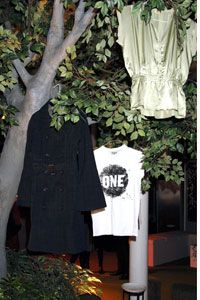
Clothing hangs from a tree at the 2006 launch party of Edun One, a label owned by the rock star Bono and his wife, Ali Hewson, in London.
DAVE M. BENETT/GETTY IMAGES
Many consumers switch to organic products out of concern for the environment. Some consider ethical factors like animal rights and fair labor practices when making purchases. However, others are simply drawn to the quality of organic and sustainable fabrics. Consumers are catching on to the organic clothing trend. In 2003, sales of organic women’s clothing grew more than 30 percent. Organic infants’ clothing and diaper sales grew more than 20 percent and sales of men’s clothing grew by 10 percent [source: OCA and OTA].
Some designers try to persuade consumers that organic clothing can improve health by reducing stress and hydrating and detoxifying the body. However, no studies have linked eco-friendly fabrics to good health. The health benefits of organic clothing are more indirect. Organic production methods result in fewer toxic emissions into the air, water and soil.
Many consumers remain concerned about the price of organic items. When you shop for organic cotton, you can expect T-shirts blended with 10 percent organic fiber to raise the price about 7 cents. Products that use 100 percent organically grown cotton can cost up to 20 to 50 percent more than conventional clothes [Source: Sustainable Cotton Project].
High-end clothing comes with steep prices, regardless of whether it’s organic or not. Mainstream retailers like the Gap, L.L. Bean, Nike and Levi’s have begun offering organic products at more comfortable price points. In 2003, American Apparel rolled out a line of cotton clothing called Sustainable Edition. Even bargain stores like Wal-Mart are beginning to offer eco-friendly clothing lines.

High-end designers have embraced organic clothing. The Oscar de la Renta gown (L) is made from silk, hemp and Polylactic Acid (PLA), a corn-based polyester. The Halston dress is also made from PLA.
PHOTO BY SCOTT OLSON/GETTY IMAGES
Clothes made from organic cotton, hemp, bamboo and recycled soda bottles are making a splash in sports apparel. Gaiam offers a line of ActiveSoy active wear made from leftover soy fluid products like soybean oil, tofu and soy milk. The liquid waste is spun into yarns that are then blended with cotton. Hind makes a T-shirt called the Stratus, blended from 60 percent polyester and 40 percent bamboo. Patagonia has been a leader in organic sportswear since it began using organic fabrics in 1996. The company uses 100 percent organic cotton in its outdoor collection and uses fibers made from recycled soda bottles to spin fleece fabric.
As organic and sustainable clothing become more affordable, it’s easier for anyone to buy organic products. However, some critics warn that large retailers’ low prices are possible because industrial organic farms are not as stringent in their practices as small, local operations.
In the next section, we’ll learn about the health risks associated with pesticides and insecticides and look at the downsides of organic clothing.
Vegan Clothing
Veganism is a cruelty-free diet and lifestyle that avoids the consumption or wearing of animal products. People become vegans for environmental, ethical, health and religious reasons.
Most vegans do not wear leather, fur, wool, down or silk. However, some vegans rationalize silk as an acceptable material because it is an insect rather than animal product.
For companies that sell leather and fur alternatives, visit PETA’s Shopping Guide
Why Wear Organic Clothing?
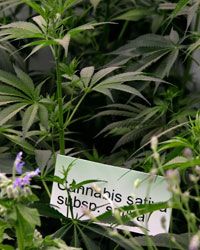
Cannabis sativa plants are displayed during the Chelsea Flower show held in London. The plants have been cultivated are grown strictly for their fiber.
MILES WILLIS/GETTY IMAGES
There are about 12.8 million acres of conventional cotton grown in the United States with about four pounds of cotton produced per acre. Fifty-five million pounds of pesticides were sprayed on those 12.8 million acres, ranking cotton third behind corn and soybeans in pesticide dependence. Worldwide, cotton is also a pesticide-heavy crop, using approximately 25 percent of the world’s insecticides and 10 percent of the world’s pesticides. In comparison, there were approximately 6,500 acres of certified organic cotton planted in the United States in 2005. Wool production also requires high levels of insecticides and antibiotics to protect animals from pests and disease [source: OTA].
Synthetic and chemical pesticides and fertilizers are associated with some sobering statistics.The Environmental Protection Agency (EPA) considers seven of the top 15 pesticides used on cotton in the United States as “possible,” “likely,” “probable,” or “known” to cause cancer in humans [source: EPA].
Pesticides have been shown to cause a range of health concerns in humans, ranging from headaches, fatigue, nausea, asthma, cancers, neurological disorders and birth defects. The United States Agency for Toxic Substances and Disease Registry reports that children exposed to methyl parathion, an insecticide, suffer memory loss and emotional swings. The World Health Organization estimates that pesticides poison at least three million people every year, with 200,000 people dying from pesticide poisoning annually [source: PANNA].
Organic agricultural methods help minimize our exposure to toxins like pesticides and insecticides. Organic farming also uses 50 percent less energy than conventional farming [source: Rodale Institute]. However, organic and sustainable clothing are not problem-free.
Hemp, because of its association with the recreational drug marijuana, has a tricky reputation to overcome. Although the plants grown for fiber are of a different variety than the drug, the politics of hemp has made it illegal to grow the plant in the United States. It is harvested successfully throughout Europe, Russia, China and Canada.
The high demand for bamboo can lead to deforestation to make room for plantations. Bamboo harvesting and processing are often unregulated. Sustainable materials made from soy and Tencel consume large amounts of energy during production.
Washing cotton clothing also requires a large amount of energy. Cotton fabric usually requires more frequent cleaning than other fabrics. A study at Cambridge University found that 60 percent of the emissions generated by a single cotton T-shirt could come from the multiple washes and tumble dryings it would require [source: Cambridge University].
To learn more about organic clothing and organic farming, look over the links on the next page.
Lots More Information
Related HowStuffWorks Articles
- How Freegans Work
- How Organic Farming Works
- How Organic Food Works
- How Smart Clothes Work
- How Vegans Work
- How does he
Sources
How Sustainable Travel Works
By: Clint Pumphrey

Image Gallery: Paradise Sustainable travel can include relaxing on a hammock at an eco resort. See pictures of paradise.
JUPITERIMAGES/GOODSHOOT/THINKSTOCK
Worldwide, the economic and environmental impact of travel is enormous. The World Travel and Tourism Council (WTTC) estimates that industries dealing directly with tourists contributed more than $1.7 trillion to global GDP in 2010; add indirect contributions and that figure soars to $5.7 trillion [source: WTTC]. The mileage logged by travelers is also impressive. In 2008, Americans alone traveled 6.5 billion miles (10.5 billion kilometers) on domestic flights and another 3 trillion miles (4.8 trillion kilometers) on the road [source: RITA]. Travel within and among other countries undoubtedly adds trillions of additional miles, resulting in an extraordinary amount of greenhouse gas emissions. So how can businesspeople and vacationers minimize the environmental consequences of their trips while maximizing the amount of money they infuse into the local economies? This question is the basis for the recent movement toward sustainable travel.
Sustainable travel emerged from the idea of ecotourism, which The International Ecotourism Society (TIES) defines as “responsible travel to natural areas that conserves the environment and improves the well-being of local people.” Both concepts emphasize the importance of green travel and accommodations, as well as activities and experiences that benefit the local economy. Sustainable travel goes a step further, though, encouraging these practices not only for trips to natural areas, but for trips to any destination. There are many ways you can practice sustainable travel, from choosing hotels that conserve electricity and water to buying food and other goods that are produced locally. You might even consider volunteering or farming in the communities you visit. Basically, by being environmentally conscious while assisting and empowering the local population, you can help to ensure that your destination will be preserved for future generations to enjoy.
However, in a world where everyone claims to be “going green,” it’s difficult to know exactly which hotels, tour operators and transportation services are actually taking meaningful steps to protect the environment and help local people. Luckily, there are an increasing number of nonprofit groups that can assist you in your search. Their Web sites detail the green credentials of accommodations across the globe, and some organizations even certify hotels and other operations as eco-friendly. Whether your trip is long or short, business or pleasure, these Web sites are an excellent reference.
Want more information? Buy some carbon offsets and take a trip through our sustainable travel guide.
How to Travel Sustainably
Brian T. Mullis, president of the nonprofit organization Sustainable Travel International (STI), defines sustainable travel as “travel that supports conservation of the environment, preservation of cultural heritage, and development of the localized economy” while also encouraging “cross-cultural understanding.” Using categories suggested by Mullis’s definition, here are some ways you can make your next trip more sustainable:
Conservation of the environment: You can take steps toward this goal before you even leave home by unplugging your appliances and utilizing paperless online services to book your travel. If you have to fly, take nonstop flights and pack less in order to reduce your overall fuel consumption. It’s also a good idea to bring your own lunch, water bottle and reusable shopping bag when you travel to minimize the amount of waste you produce. Once you arrive at your destination, avoid using a car if possible by walking or taking public transportation. Your accommodations and tour operators should also engage in sustainable practices like energy and water conservation, recycling and composting. Want to do more? Purchase carbon offsets, which are basically donations to green energy projects intended to offset the carbon emissions incurred during your trip.
Preservation of cultural heritage: Avoid chain hotels that offer the same experience regardless of your location, insulating you from the local culture. Instead, opt for accommodations and experiences that immerse you in the customs and traditions of your destination. When dealing with locals, consider yourself a visitor in their home. Be respectful and show interest in their way of life instead of demanding that they submit to yours.
Development of the localized economy: If possible, choose local guides, stay in locally-owned accommodations, and eat locally-grown food. You should also buy souvenirs from local artisans, but be careful not to purchase any products made from endangered plant or animal species. These steps will ensure that as much of your money as possible is infused into the local economy.
Cross-cultural understanding: To develop a greater appreciation for local heritage, consider visiting during a festival, when many customs and traditions are on display. Another way to immerse yourself in the culture of your destination is through voluntourism and agritourism. These terms describe vacations during which tourists volunteer with local projects or learn about farming from local cultivators.
Now that you know how to travel sustainably, click over to the next page and learn how to plan your sustainable trip.
Keeping it Green
A survey commissioned by Element Hotels in 2007 suggests that people aren’t as likely to practice green habits when they’re on vacation. Sixty-three percent of respondents admitted that they are less likely to turn off the lights when they leave a hotel room than when they leave their home. Furthermore, though 70 percent said that they try to conserve water at home, only 20 percent said they do so when traveling. Just remember that even if it doesn’t cost you any more to use the lights, water and air conditioning at your hotel, it still impacts the environment [source: Element]!
How to Plan a Sustainable Trip
A study conducted in 2002 by the Travel Industry Association of America and funded by National Geographic Traveler magazine revealed that Americans are receptive to many of the goals of sustainable travel:
- Seventy-one percent of respondents felt that their visit to a destination should not harm its environment.
- Sixty-one percent enjoy their experience more when the destination preserves its natural, historic, and cultural sites and attractions.
- Fifty-three percent have a better travel experience when they learn about the customs, geography, and culture of a destination.
[source: TIA]
Unfortunately, as these attitudes have become increasingly mainstream, some hotels and transportation companies have attempted to make themselves sound greener than they really are through a process known as greenwashing. Luckily, numerous resources are now available to guide the eco-conscious in the right direction when it comes to sustainable travel.
Greenwashing is a problem in many areas, not just the travel industry. A 2007 study by TerraChoice Environmental Marketing found that all but seven of 1,018 products used misleading or false labeling to promote their products as eco-friendly [source: TerraChoice]. A common greenwashing tactic in hotels is to ask patrons to reuse their towels and linens instead of washing them daily. Though signs may proclaim this practice will “save the environment,” it’s really more of a cost-saving measure for the hotel than anything else. A famous example in the airline industry involved British Airways’ widely-praised plan to give customers the chance to buy carbon offsets when they booked their flight. However, after 20 months, only 0.01 percent of the airline’s total carbon emissions had actually been offset.
You can avoid greenwashed accommodations and travel with the help of some nonprofit groups and a little personal research. Currently, no single regulating body exists to oversee green certification in the travel industry. There are, however, several independent organizations that certify ecolodges, including STI and TIES. You can also look for more general recognitions like the Green Seal, Energy Star or GGBC certification. If the hotel or tour operator isn’t certified, you can research it on numerous Web sites, including Environmentallyfriendlyhotels.com, Greenhotels.com, Safertraveldirectory.com, Greenlodgingnews.com, and Gogreentravelgreen.com. If all else fails, call the hotel or tour operator and ask them about their environmental policies. If the clerk has trouble responding, you should probably move on.
Ready to start researching? Click over to the next page for some great links.
Green Accommodations
A great example of an ecolodge is the Playa Nicuesa Rainforest Lodge in Costa Rica. Designed by a local architect, the buildings are constructed from fallen trees and recycled materials. They’re powered with solar panels, and a backup generator runs on recycled vegetable oil. The local community also benefits from the lodge’s operation. Ninety-eight percent of lodge employees are local, and much of the food, hardware and other supplies are purchased locally. The lodge also donates to several local charities. These are just a sampling of the efforts that have earned the Playa Nicuesa Rainforest Lodge a certification from both Sustainable Travel International and The International Ecotourism Society.
Lots More Information
Related Articles
Sources
What’s more sustainable, mass-produced or handcrafted furniture?
By: Molly Edmonds

What’s it gonna be? See more pictures of home design.
THOMAS BARWICK/DIGITAL VISION/GETTY IMAGES
Congratulations! You finally won the lottery, and now you have a few thousand dollars to redecorate your living room. Of course you’re going to be looking for comfortable and good-looking furniture, but you have another criterion as well. You want your new piece of furniture to be sustainably made and good for the environment. So what should you buy?
While green products are all the rage right now, the furniture industry lags behind. After all, the industry’s success is based on folks wanting to redecorate every few years. Until recently, there was no way to really know how sustainable your furniture was, or what sustainability might mean in relation to furniture. Enter the Sustainable Furniture Council (SFC). Formed in 2006, the SFC is working to promote environmentally responsible practices in the furniture industry in the United States. It’s also developing an identification label that will help customers find furniture that meets earth-friendly guidelines.
And what might those guidelines entail? The SFC uses a Life Cycle Analysis to measure a product’s environmental impact. You may think of a life cycle as the time from the cradle to the grave, but the SFC and its members will be trying to get us to think about how a product can go from cradle to cradle. If a product starts life as a raw material, how can it then serve as a raw material for another product? And what did it do in between those times — was it shipped around the world, or did it remain local? Did it spend its time emitting harmful chemicals and ruining indoor air quality? Did its maker produce a ton of waste in creating it? These are the types of issues to consider when furniture shopping.
Of course, one of your best bets for earth-friendly furniture is buying secondhand, particularly investing in antiques. This recycled furniture doesn’t require any additional environmental impact. Also, when you buy an antique that is more than 50 years old, it lacks the toxic chemicals and substances that some furniture can emit [source: Bartolucci].
But for the sake of this article, let’s say you want new furniture. You’ve been window shopping, and you’ve narrowed down your options. For that corner by the window, you’re either going to go with a mass-produced chair or a handcrafted chair. What is the life cycle of each? Which should you buy? Turn the page to find out.
Sustainable Furniture

Do you know what you’re sitting on?
E. DYGAS/RISER/GETTY IMAGES
Let’s say you’ve settled on buying either a handcrafted wooden rocking chair from a local craftsman or a plush armchair from a furniture store in the mall with your winnings. How does each fare on sustainability?
To start the life cycle analysis of this furniture, look at the different materials that went into these pieces. It’s best if the materials are locally sourced, but there are some other things to look for. If the piece is made of wood, then you’ll want to check that the wood was approved by the Forest Stewardship Council, which certifies wood that meets environmental guidelines. Any fabrics should be organic materials such as cotton, wool or hemp, and metal should be recycled. Because some furniture finishes are high in volatile organic compounds (VOCs) that give off harmful air pollutants, look for paints, foams and glues that are certified as low-VOC. Mass-produced pieces are more likely to release VOCs thanks to things like formaldehyde and foam cushions doused with chemical flame retardants; that’s strike one for that plush armchair.
The main differences in these pieces are how and where they were made. Work by hand takes less energy than a mass production assembly line, provided that the craftsman works to reduce his waste effectively. A lot of energy also can go into shipping a piece of furniture. Because more mass production is being sourced to Asian countries, that chair might have already racked up quite the carbon footprint in its journey to the mall. Instead, you’ll want to look for furniture that is manufactured nearby, using local materials when possible. Unless you have an energy-efficient manufacturing plant down the road, the handcrafted rocking chair from the local craftsman definitely comes out ahead in this round.
And the last step in the life cycle analysis — how can the piece be used after you’re done with it? Can it be recycled into another product, is it biodegradable or will it sit in a landfill? Furniture accounted for more than 18 million pounds (6.2 million kilograms) of waste in 2006, the most of any durable good [source: The Press-Enterprise]. And while organizations such as Earth911 and Freecycle will help your mass-produced chair find a new home, it’s more earth-friendly to see your furniture as an heirloom, not a disposable commodity. Handcrafted furniture tends to last longer, so you may be buying less furniture overall than if you purchased a couch that only has a few years of life in it. Another point awarded to the rocking chair.
Ultimately, the rocking chair wins this sustainability contest. It was made locally with renewable wood, and it will far outlast the stuffed armchair. Another advantage you have when buying handcrafted pieces is the ability to talk with the craftsman directly about some of these life cycle issues. It’s unlikely that a salesperson in the mall would have the answers, but the SFC certification could eventually help consumers make more informed decisions.
But sustainable furniture doesn’t come cheap; there’s usually a premium of about 20 to 30 percent over mass-produced furniture [source: Hasek]. Great, you may think — this lottery money won’t last forever, and I won’t always have the dough to spend on sustainable handcrafted furniture. A mass-produced couch just may fit my budget better. Well, consumer interest and demand may be one reason why the big guys haven’t gone green yet. Until the masses show interest in sustainable furniture, there’s no incentive for manufacturers to adjust their practices.



